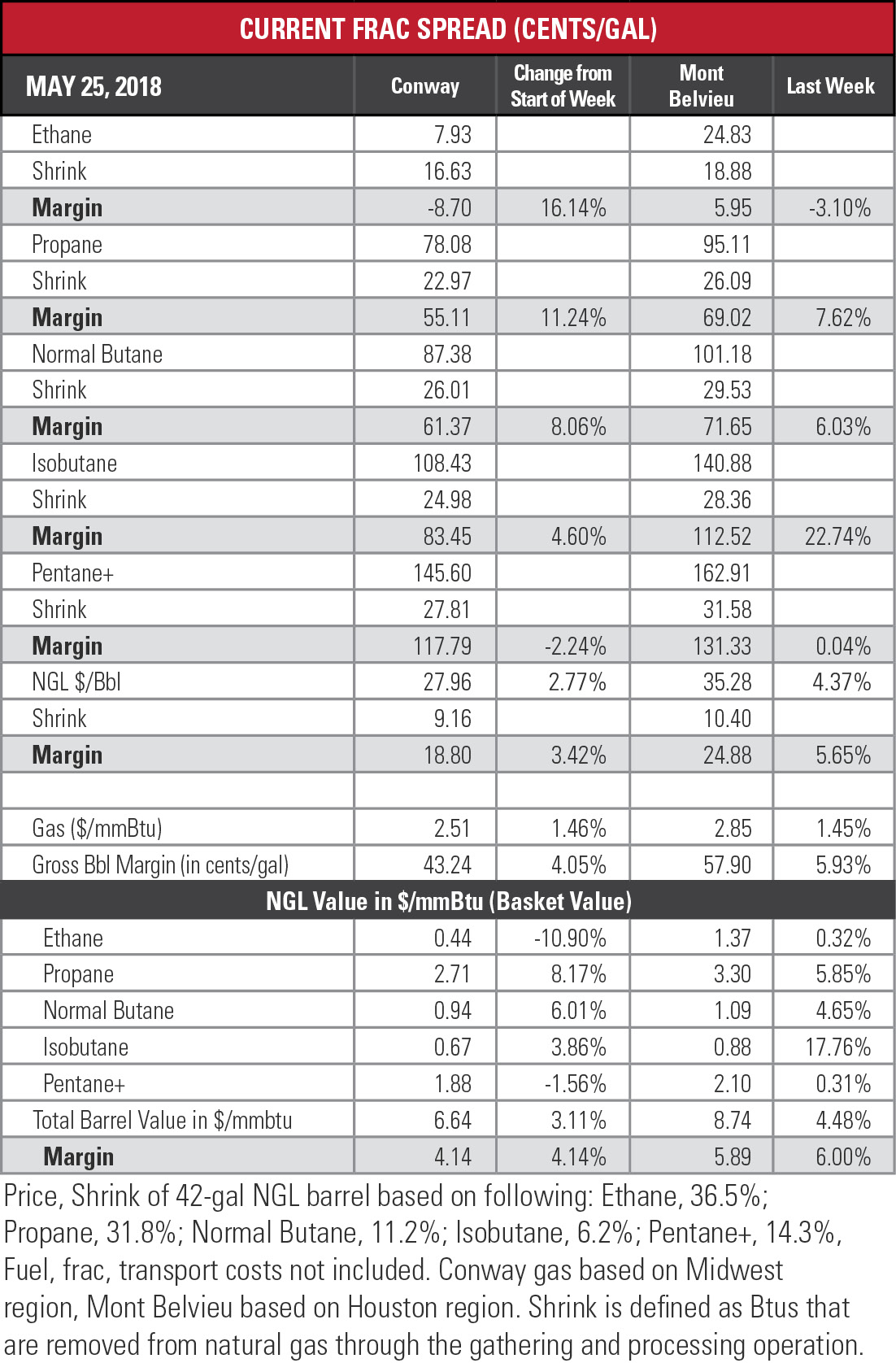
It was a good week to be an NGL molecule.
Your output was high enough, your demand was strong enough and, doggone it, energy traders liked you.
Except for you, ethane. You endured more of a compare-and-despair week.
The hypothetical NGL barrel at Mont Belvieu, Texas, climbed above $35 last week to its highest mark since mid-October 2014—a 43-month stretch. Isobutane was exceptionally strong, leaping 17.8% to $1.41 per gallon (gal), its highest price since mid-February 2015, or 51 months.
 Eight of 10 prices at Mont Belvieu and Conway, Kan., experienced price hikes in the past week. Ethane, though, struggled. Its Mont Belvieu price remained static while the price of natural gas rose slightly, squeezing its margin by 3.1% and pulling it below 6 cents/gal. This despite the restart of the Mariner East 1 pipeline that connects to Marcus Hook, Pa. An ethane-laden tanker departed the terminal, En*Vantage Inc. noted in its weekly report.
Eight of 10 prices at Mont Belvieu and Conway, Kan., experienced price hikes in the past week. Ethane, though, struggled. Its Mont Belvieu price remained static while the price of natural gas rose slightly, squeezing its margin by 3.1% and pulling it below 6 cents/gal. This despite the restart of the Mariner East 1 pipeline that connects to Marcus Hook, Pa. An ethane-laden tanker departed the terminal, En*Vantage Inc. noted in its weekly report.
Traders are skittish about ethane demand, in part because Chevron Phillips Chemical Co. LP, experiencing an ethane surplus, announced that it would idle its Sweeny #22 cracker. By itself, it’s not a big deal but it symbolizes the malaise surrounding ethane.
“The ethylene surplus that Chevron Phillips is facing is emblematic of the industry-wide surplus of ethylene facing many U.S. petrochemical producers,” En*Vantage wrote in its report.
 Sweeny #22 is the smallest and highest cracker that Chevron Phillips operates, but its closing means that ethane cracking demand is diminished at a time when low natural gas prices are spurring higher ethane extraction in the Permian Basin, Rockies and Midcontinent, En*Vantage said.
Sweeny #22 is the smallest and highest cracker that Chevron Phillips operates, but its closing means that ethane cracking demand is diminished at a time when low natural gas prices are spurring higher ethane extraction in the Permian Basin, Rockies and Midcontinent, En*Vantage said.
Given that other ethane crackers are running full tilt and ethane exports from Morgan’s Point on the Houston Ship Channel are strong, the drop in prices signals a market overreaction, the analysts concluded. Traders are also not taking the near-term demand boost from Exxon Mobil Corp.’s 3.3 billion pound-per-year ethane cracker in Baytown, Texas, which is on track to be operational by mid-year.
The isobutane prices could indicate an outage of a splitting tower at Mont Belvieu, En*Vantage speculated. The analysts also noted reports of fractionator shutdowns for planned maintenance at Mont Belvieu.
 In the week ended May 18, storage of natural gas in the Lower 48 experienced an increase of 91 billion cubic feet (Bcf), compared to the Bloomberg consensus forecast of 92 Bcf, the U.S. Energy Information Administration reported. The figure resulted in a total of 1.629 trillion cubic feet (Tcf). That is 33% below the 2.433 Tcf figure at the same time in 2017 and 23.4% below the five-year average of 2.128 Tcf.
In the week ended May 18, storage of natural gas in the Lower 48 experienced an increase of 91 billion cubic feet (Bcf), compared to the Bloomberg consensus forecast of 92 Bcf, the U.S. Energy Information Administration reported. The figure resulted in a total of 1.629 trillion cubic feet (Tcf). That is 33% below the 2.433 Tcf figure at the same time in 2017 and 23.4% below the five-year average of 2.128 Tcf.
Joseph Markman can be reached at jmarkman@hartenergy.com and @JHMarkman.
Recommended Reading
E&P Highlights: Dec. 30, 2024
2024-12-30 - Here’s a roundup of the latest E&P headlines, including a substantial decline in methane emissions from the Permian Basin and progress toward a final investment decision on Energy Transfer’s Lake Charles LNG project.
Nabors, ProPetro Plan to Deliver High Voltage to Drillers
2024-12-10 - Nabors Industries, in partnership with e2Companies, and, separately, ProPetro Holding Corp., both launched oilfield electrification solutions on Dec. 10.
E&P Highlights: Jan. 6, 2025
2025-01-06 - Here’s a roundup of the latest E&P headlines, including company resignations and promotions and the acquisition of an oilfield service and supply company.
E&P Highlights: Dec. 16, 2024
2024-12-16 - Here’s a roundup of the latest E&P headlines, including a pair of contracts awarded offshore Brazil, development progress in the Tishomingo Field in Oklahoma and a partnership that will deploy advanced electric simul-frac fleets across the Permian Basin.
Partnership to Deploy Clean Frac Fleets Across Permian Basin
2024-12-13 - Diamondback Energy, Halliburton Energy Services and VoltaGrid are working together to deploy four advanced electric simul-frac fleets across the Permian in an effort to enhance clean and efficient energy solutions in the region.
Comments
Add new comment
This conversation is moderated according to Hart Energy community rules. Please read the rules before joining the discussion. If you’re experiencing any technical problems, please contact our customer care team.





